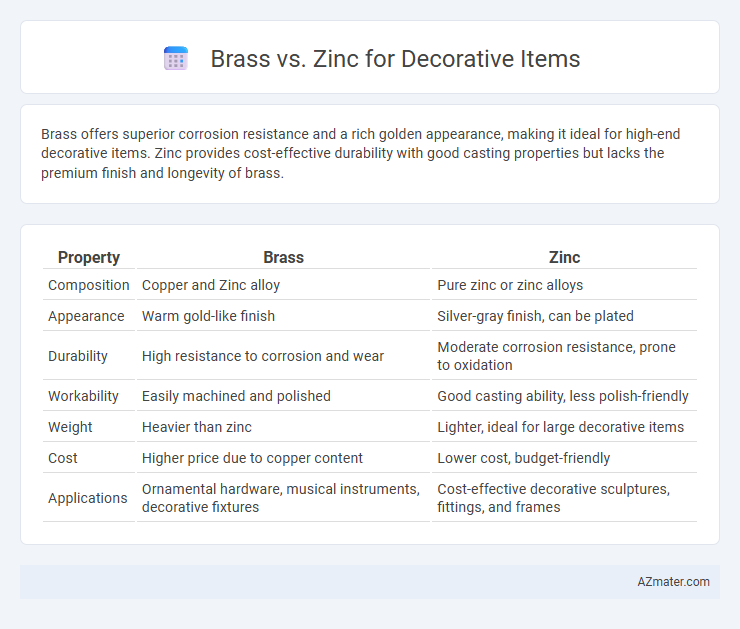Brass offers superior corrosion resistance and a rich golden appearance, making it ideal for high-end decorative items. Zinc provides cost-effective durability with good casting properties but lacks the premium finish and longevity of brass.
Table of Comparison
| Property | Brass | Zinc |
|---|---|---|
| Composition | Copper and Zinc alloy | Pure zinc or zinc alloys |
| Appearance | Warm gold-like finish | Silver-gray finish, can be plated |
| Durability | High resistance to corrosion and wear | Moderate corrosion resistance, prone to oxidation |
| Workability | Easily machined and polished | Good casting ability, less polish-friendly |
| Weight | Heavier than zinc | Lighter, ideal for large decorative items |
| Cost | Higher price due to copper content | Lower cost, budget-friendly |
| Applications | Ornamental hardware, musical instruments, decorative fixtures | Cost-effective decorative sculptures, fittings, and frames |
Introduction: Brass vs Zinc in Decorative Items
Brass and zinc are popular materials used in decorative items, each offering unique aesthetic and functional properties. Brass, an alloy of copper and zinc, is prized for its warm golden color, corrosion resistance, and malleability, making it ideal for intricate designs and vintage finishes. Zinc, known for its low melting point and cost-effectiveness, provides a lightweight yet durable option often used for modern, sleek decorative pieces with excellent resistance to oxidation.
Material Composition and Properties
Brass, an alloy primarily composed of copper and zinc, offers a warm golden appearance and superior corrosion resistance, making it ideal for decorative items requiring durability and aesthetic appeal. Zinc, a more affordable base metal often used for die-casting, provides good dimensional stability but tends to lack the luster and strength found in brass. The higher copper content in brass enhances its malleability and natural antimicrobial properties, whereas zinc's lower melting point facilitates easy molding but generally results in less robust finished products.
Aesthetic Appeal: Color and Finish
Brass offers a warm, golden hue with a natural luster that enhances decorative items by conveying a classic, luxurious aesthetic. Zinc, often finished with plating or powder coating, provides a more contemporary and versatile appearance with options ranging from matte to glossy finishes. The choice between brass and zinc influences the decorative item's visual impact, with brass favoring timeless elegance and zinc favoring modern adaptability.
Durability and Longevity
Brass offers superior durability compared to zinc due to its resistance to corrosion, tarnishing, and wear, making it ideal for decorative items exposed to varying environmental conditions. Zinc tends to be softer and more prone to oxidation, which can reduce the longevity and appearance of decorative pieces over time. Choosing brass ensures a longer-lasting, more robust decorative item with minimal maintenance required.
Corrosion Resistance Comparison
Brass exhibits superior corrosion resistance compared to zinc, making it more suitable for decorative items exposed to moisture or outdoor environments. The copper content in brass forms a protective patina over time, preventing rust and degradation. Zinc tends to corrode faster when exposed to acidic or humid conditions, reducing its longevity in decorative applications.
Weight and Handling Differences
Brass, an alloy of copper and zinc, is denser and heavier than zinc, providing a solid, premium feel to decorative items. Zinc, being lighter and more malleable, allows for easier handling and intricate designs but may lack the substantial weight that brass offers. This weight difference directly impacts the perceived quality and durability of decorative pieces, making brass ideal for robust, long-lasting items while zinc suits lightweight, detailed ornaments.
Cost Effectiveness for Decorative Products
Brass offers superior durability and a luxurious finish but comes with a higher price point, making it a premium choice for decorative items. Zinc is more cost-effective, providing adequate strength and corrosion resistance at a lower cost, ideal for budget-conscious decorative products. Manufacturers often select zinc for mass production due to its affordability and ease of casting, while brass is reserved for high-end, intricate designs where cost is less of a concern.
Workability and Manufacturing Process
Brass offers superior workability compared to zinc due to its high malleability and ease of casting, making it ideal for intricate decorative items with fine details. The manufacturing process of brass involves straightforward melting and alloying of copper and zinc, allowing precise control over composition for varied mechanical properties. Zinc, while less malleable, excels in die casting with fast production cycles and lower melting points, but it may require additional finishing to enhance surface detail and durability in decorative applications.
Environmental Impact and Sustainability
Brass, an alloy primarily of copper and zinc, offers high durability and recyclability, making it a sustainable choice for decorative items despite the environmental impact from copper mining. Zinc, while more abundant and requiring less energy for extraction and processing, can pose challenges in recycling due to its lower melting point and potential for metal fatigue. Choosing brass may result in a longer product lifespan and higher recyclability, whereas zinc's lower initial environmental footprint could benefit short-term, low-impact decorative applications.
Choosing the Right Metal for Your Decor
Brass offers a warm, golden hue and excellent corrosion resistance, making it ideal for decorative items in both indoor and outdoor settings. Zinc is valued for its affordability, lightweight nature, and ability to be easily molded into intricate designs, though it may require additional coatings to prevent tarnishing. Selecting between brass and zinc depends on the desired aesthetic durability, and budget considerations for your decor project.

Infographic: Brass vs Zinc for Decorative Item
 azmater.com
azmater.com